The Samsung Galaxy Note5 and Galaxy S6 edge+ Review
by Joshua Ho on October 2, 2015 8:00 AM ESTBattery Life
Battery life is undoubtedly one of the most important parts of the user experience of any mobile device. One of the major reasons why many people use phablets is to get better battery life, as the PCB size of a phablet is often roughly similar to what you’ll see in a smartphone, but the battery will be bigger to fill the available space. As a result, a phablet has a higher proportion of battery than a smartphone. This inherently means that battery size will scale faster than platform power. In order to test this metric, we use a number of different tests ranging from display-bound web browsing to SoC-bound CPU and GPU load tests. In order to eliminate confounding variables, we test all devices from the same ASUS RT-AC68U router for WiFi testing, and in strong LTE/3G reception for mobile web browsing, in addition to setting all devices to an average of 200 nits on the display.
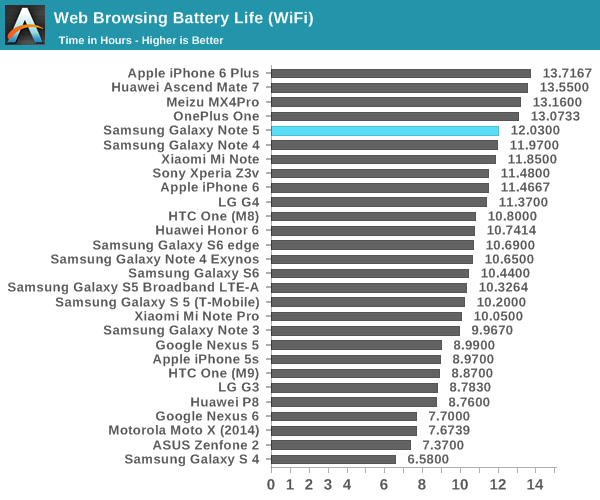
In our first test of WiFi web browsing, the Galaxy Note5 performs identically to the Galaxy Note 4. This might be surprising because the display is the same size and resolution as the Galaxy Note 4 with a smaller battery than the Galaxy Note 4. However, the smaller battery is compensated for due to improvements in SoC and display efficiency. In particular, the move from a planar 28nm process to a 14nm FinFET process dramatically reduces power consumption on the SoC.

In LTE battery life, we see a noticeable drop relative to WiFi battery life. It’s likely that this is mostly due to the power consumption of the Shannon 333 modem present in these devices. There’s not much else to say here, but battery life is still good.
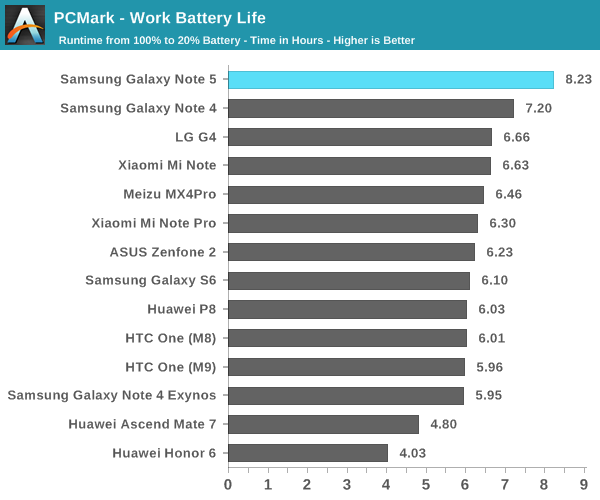
Moving past our mostly display-bound web browsing test, PCMark provides a much more balanced look at battery life as APL tends to vary a bit more with content like videos and photos instead of just webpages, and the CPU component is much more strongly emphasized. Here we can really see the Note5’s Exynos 7420 stretch its legs as it keeps a high performance level with long runtime.
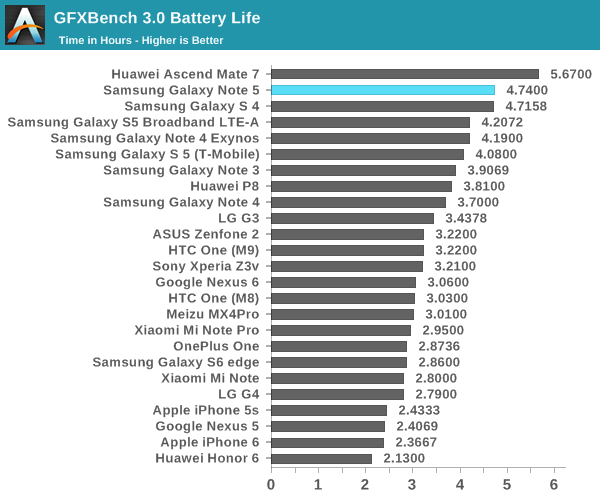
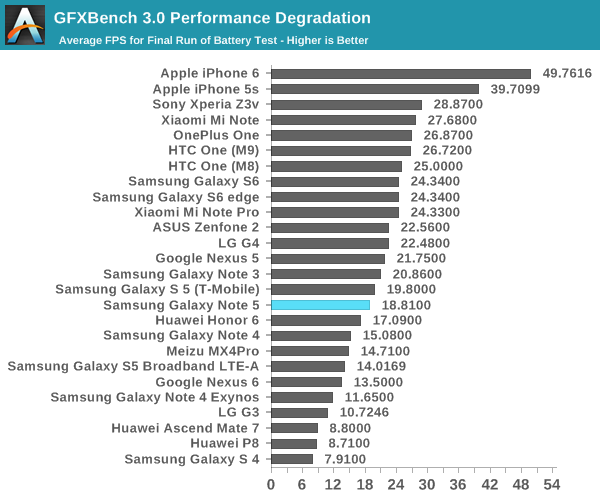
In our sustained SoC-bound workloads, GFXBench shows a healthy improvement over the Galaxy S6. Although we’re unable to test in perfectly controlled temperatures, it looks like Samsung has improved the throttling behavior of the SoC as the throttling appears to be more graceful rather than sinusoidal, and the result is a pretty significant jump in runtime over most devices.
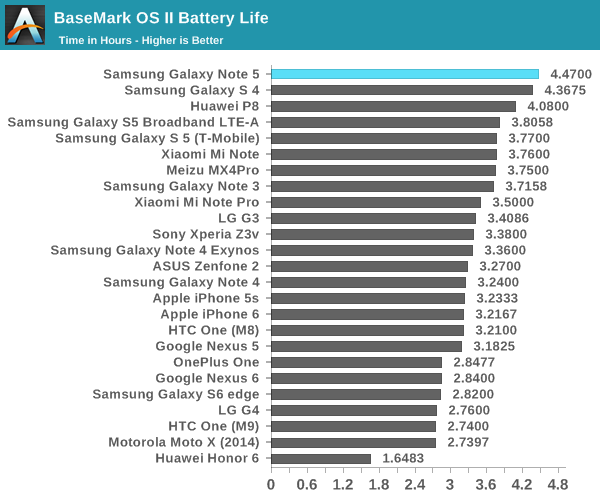

In Basemark OS II, we see a pretty significant uplift in runtime when compared to something like the Galaxy S6 or Note 4. The runtime increase isn’t just due to excessive throttling though, as the battery score shows that this isn’t just a case of throttling the CPU until the runtime is an improvement over past devices.
Overall, if you’ve read the Galaxy S6 review it’s pretty fair to say that you’ll know what to expect from the Galaxy Note5. Battery life is roughly equivalent to the Galaxy Note 4 despite the smaller battery, and due to the greatly improved Exynos 7420 SoC relative to 2014 SoCs SoC-bound cases will show pretty healthy improvements as long as you’re controlling for performance.
Charge Time
While normally battery life is the primary area of concern for a smartphone, in some cases it’s important for a phone to charge quickly. We can all claim to be perfect but one of the simplest cases for faster charging is forgetting to plug the phone in before going to sleep, so the maximum allowable charge time goes from something like 6 hours to an hour at best. As a result, a faster charger can dramatically improve practical battery life in any situation where you have limited time to charge. This can be accomplished by increasing either the current or voltage of the charger. The original quick charging standards improved charge rate through higher current, but this eventually hits a wall due to resistance in the wire. In order to increase the total amount of power delivered without increasing the thickness of the cable used voltage was increased in the case of newer standards like QC 2.0. In the case of the Galaxy Note5 and Galaxy S6 edge+, we’re looking at the same 9V, 1.67A QC 2.0 compatible charger that shipped with the Galaxy Note 4. In order to test this properly, we log the time it takes for the phone to charge by running a timer until the charger power draw hits a point that represents 100% battery.
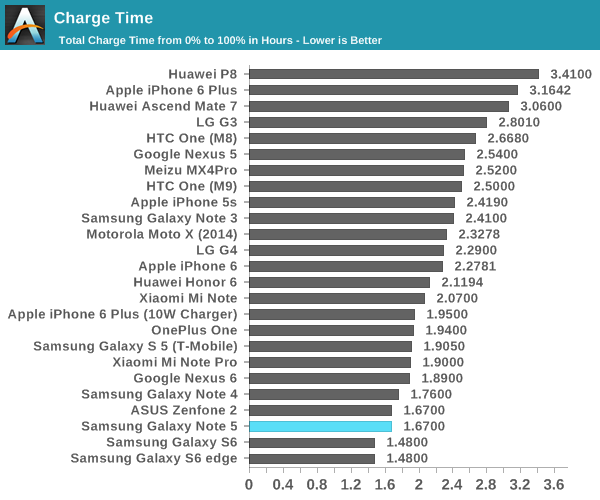
It probably isn’t a surprise, but charge time ends up similar to the Galaxy S6 and Galaxy Note 4. I suspect that we’ll be waiting until QC 3.0 to be able to see significant improvements as the current standard doesn’t have particularly fine-grained voltage scaling according to cable and phone conditions. Interestingly, the wireless fast charger is actually not too far off from the wired charger as it indicates 100% around 1.84 hours into charging which is almost identical to the wired fast charger.


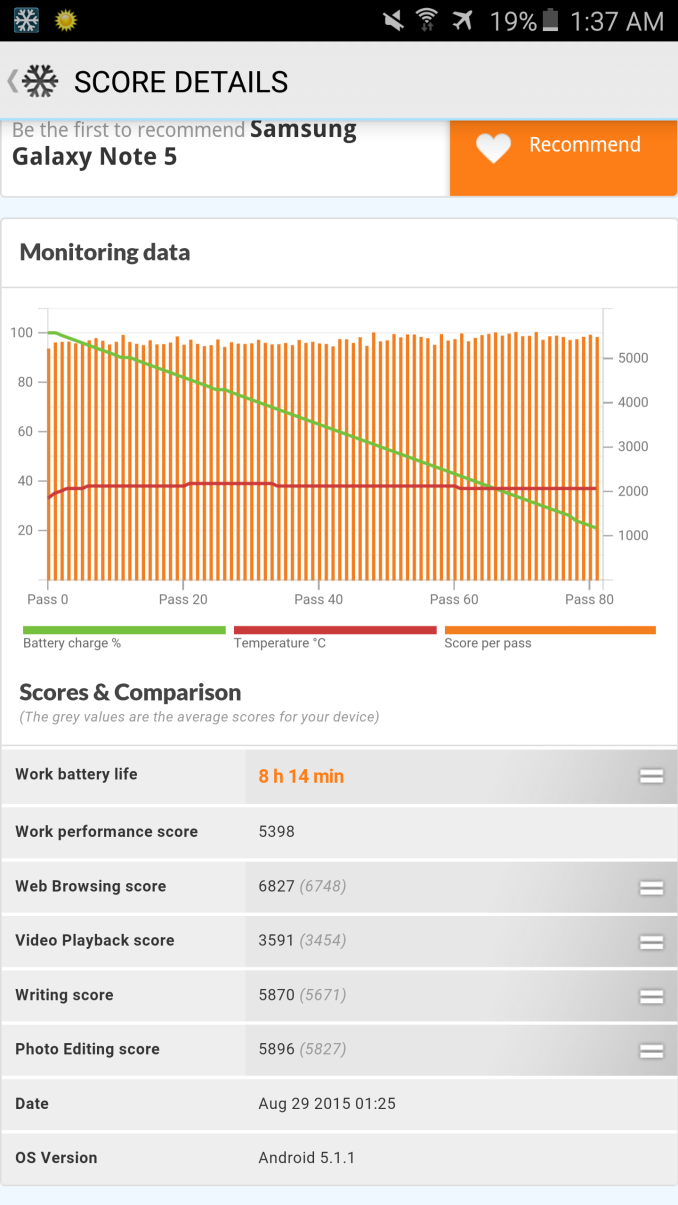
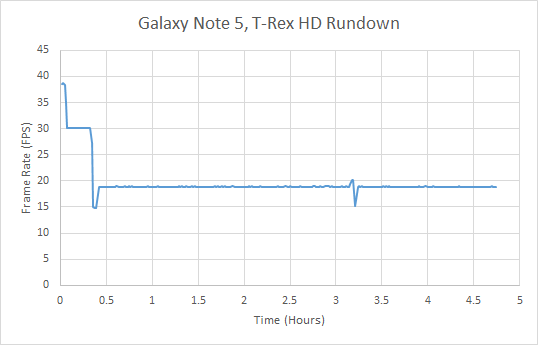
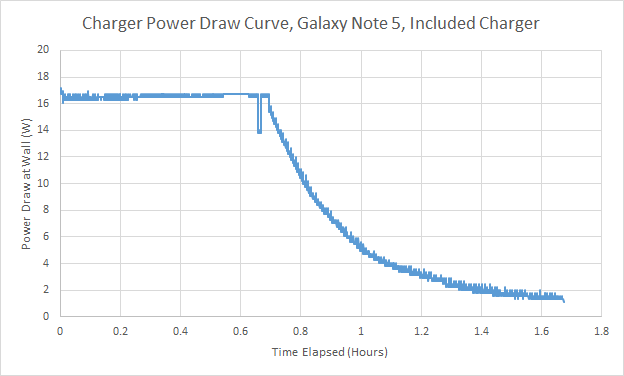
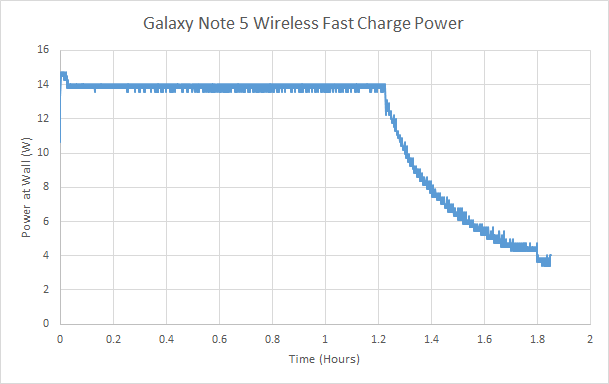








225 Comments
View All Comments
melgross - Saturday, October 3, 2015 - link
I'm not convinced that the 8/4 solution is a good one. Four weak cores, and four even weaker cores may look good in multiprocessing tests, but in the real world, it's going to lag.mercucu1111 - Friday, October 2, 2015 - link
Exynos 7420 Full load Geekbench : 5600A9 Full load Geekbench : 4400
So E7420 CPU is 30% higher.
According to GFX 3.0 and 2.7
A9 GPU is 40% higher.
So Nobody can say which is better lol
melgross - Saturday, October 3, 2015 - link
The multiprocessing tests mean little though. They're often questioned. The problem is that real world use doesn't function that way.darwinosx - Friday, October 2, 2015 - link
Heh. Kids. Apple sales have destroyed Samsung as is well known.Kuzi - Friday, October 2, 2015 - link
As of Q2 2015, Samsung has 21.4% of the Smarphone market, Apple has 13.9%:http://www.idc.com/prodserv/smartphone-market-shar...
Well known yeah right.
tipoo - Friday, October 2, 2015 - link
Is that 21% high end phones like the GS6, or all the cheap phones with razor margins they also have?hughlle - Friday, October 2, 2015 - link
Irrelevant to the statement darwinosx made.. he stated Apple sales have destroyed Samsung's sales. Clearly they havnt. The type of phones Mali g up the figures is irrelevant to that statement.lukarak - Friday, October 2, 2015 - link
Well, if you mention sales, you know, exchange of stuff for money, then money made is much much more important than unit numbers to judge someones performance. Because, they do sales to earn money, not to ship units. And Apple destroys Samsung in that regard.Kuzi - Friday, October 2, 2015 - link
Remember that since the first iPhone till now most of the SOCs used were made by Samsung. Also Samsung supplied RAM, screens, flash etc for the iPhones and iPads. The IPhone 6 SOC and RAM is supplied by samsung. So for every iPhone/IPad sold, Samsung makes money. It has been thisnway since the first IPhone, enjoy.Morawka - Friday, October 2, 2015 - link
yay apple makes more money, but samsung sells more phones.. hmm interesting. i would say android wins because they make it all up on app sales and profits